
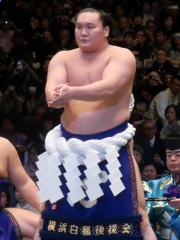
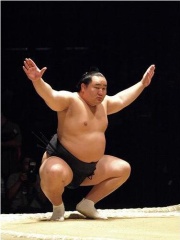

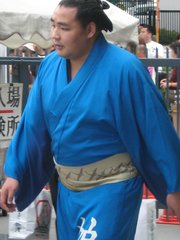
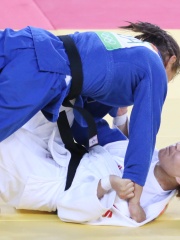

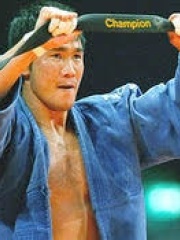
The Most Famous
WRESTLERS from Mongolia
This page contains a list of the greatest Mongolian Wrestlers. The pantheon dataset contains 1,027 Wrestlers, 13 of which were born in Mongolia. This makes Mongolia the birth place of the 23rd most number of Wrestlers behind Azerbaijan, and Armenia.
Top 10
The following people are considered by Pantheon to be the top 10 most legendary Mongolian Wrestlers of all time. This list of famous Mongolian Wrestlers is sorted by HPI (Historical Popularity Index), a metric that aggregates information on a biography's online popularity. Visit the rankings page to view the entire list of Mongolian Wrestlers.

1. Jigjidiin Mönkhbat (1941 - 2018)
With an HPI of 58.61, Jigjidiin Mönkhbat is the most famous Mongolian Wrestler. His biography has been translated into 15 different languages on wikipedia.
Jigjidiin Mönkhbat (Mongolian: Жигжидийн Мөнхбат; 1 June 1941 – 9 April 2018) was a Mongolian wrestler. Mönkhbat was the undefeated 1968 Olympic vice-champion in the 87 kg. Mönkhbat placed fourth in the middleweight (87 kg) division at the 1966 World Wrestling Championships, having lost the bronze medal match, however, he defeated the reigning three-time World Champion and the strongest 1964 Olympic wrestler Mansour Mehdizadeh of Iran in the first match. At the 1967 World Wrestling Championships Mönkhbat held a bronze medal after defeating Majid Aghili of Iran. At the 1968 Summer Olympics he won the silver medal in the men's Freestyle Middleweight category (87 kg), behind gold medalist Boris Michail Gurevich of the Soviet Union and ahead of bronze medalist Prodan Gardzhev of Bulgaria. However, Mönkhbat left the tournament as undefeated wrestler, his results in the Olympics were 4 wins, 2 draws, and 0 losses: Mönkhbat was a State Grand Champion in bökh, a top rank in the sport, with six Naadam championship wins (1963–1967, 1974). His name Mönkhbat means "Eternal firm" in the Mongolian language. Mönkhbat was the father of professional sumo wrestler Hakuhō Shō, who held the top rank of yokozuna in that sport before retiring. His son Hakuhō regards his six Nadaam championships as the equivalent of 36 tournament championships in sumo (as sumo tournaments are held six times a year) and used that as motivation to keep going even after passing Taihō's record of 32 championships.

2. Hakuhō Shō (b. 1985)
With an HPI of 51.76, Hakuhō Shō is the 2nd most famous Mongolian Wrestler. His biography has been translated into 25 different languages.
Hakuhō Shō (Japanese: 白鵬 翔; born 11 March 1985 as Mönkhbatyn Davaajargal (Mongolian: Мөнхбатын Даваажаргал; IPA: [mөnxpatʰin taw̜aːt͡ʃargaɮ])) is a Mongolian-born Japanese former professional sumo wrestler (rikishi) from Ulaanbaatar, Mongolia. Making his debut in March 2001, he reached the top makuuchi division in May 2004. In May 2007 at age 22, he became the second native of Mongolia, the fourth non-Japanese, and 69th overall rikishi to be promoted to the highest rank in sumo, yokozuna. With a record 45 total championships (yūshō) at the top makuuchi division, he is widely considered to be the greatest sumo wrestler of all time. In 2009, he broke the record for the most wins in a calendar year, winning 86 out of 90 bouts, and repeated this feat with the same record again in 2010 when he established the second longest winning streak in sumo history. He also holds the record for the most undefeated tournament championships at sixteen, which is eight more than any other sumo wrestler in history. He was the only active yokozuna from 2010, following the retirement of his rival and fellow Mongolian Asashōryū, until 2012 with the promotion of fellow Mongolian Harumafuji. In March 2021, he became the only active yokozuna once again following the retirement of his rival and fellow Mongolian Kakuryū until the promotion of fellow Mongolian Terunofuji four months later. In January 2015, he broke Taihō's long-standing record by winning his 33rd top division championship, the most in the history of sumo. He holds the records for most wins in the top division, achieved in May 2016, and most career wins, achieved in July 2017. He was the longest-serving yokozuna of all-time, having surpassed Haguroyama's record in 2019, and fought his 1000th bout as a yokozuna in July 2020. He acquired Japanese citizenship in 2019. Hakuhō retired from professional sumo at the end of September 2021, closing out a 20-year career in the sport. Sumo commentator John Gunning noted that Hakuhō left an unmatchable legacy, while Washington Post columnist Stephen Stromberg called him "possibly the most accomplished figure in any sport, ever". Hakuhō departed from the Japan Sumo Association in June 2025, after he was relieved from overseeing his stable in early 2024 following an investigation into assaults on the part of his wrestler Hokuseihō.

3. Asashōryū Akinori (b. 1980)
With an HPI of 51.27, Asashōryū Akinori is the 3rd most famous Mongolian Wrestler. His biography has been translated into 22 different languages.
Asashōryū Akinori (Japanese: 朝青龍 明徳; born 27 September 1980, as Dolgorsürengiin Dagvadorj, Mongolian Cyrillic: Долгорсүрэнгийн Дагвадорж; [tɔɮgɔrsʊːrengiːn tagw̜atɔrt͡ʃ]) is a Mongolian former professional sumo wrestler (rikishi). He was the 68th yokozuna in the history of the sport in Japan, and in January 2003 he became the first Mongolian to reach sumo's highest rank. He was one of the most successful yokozuna ever. In 2005, he became the first wrestler to win all six official tournaments (honbasho) in a single year. Over his entire career, he won 25 top division tournament championships, placing him fourth on the all-time list. From 2004 until 2007, Asashōryū was sumo's sole yokozuna between the retirement of Musashimaru and the promotion of fellow Mongolian Hakuhō, and was criticized at times by the media and the Japan Sumo Association for not upholding the standards of behaviour expected of a holder of such a prestigious rank. He became the first yokozuna in history to be suspended from competition in August 2007 when he participated in a charity football match in his home country despite having withdrawn from a regional sumo tour claiming injury. After a career filled with a multitude of other controversies, both on and off the dohyō, his career was cut short when he retired from sumo in February 2010 after allegations that he assaulted a man outside a Tokyo nightclub.

4. Naidangiin Tüvshinbayar (b. 1984)
With an HPI of 45.18, Naidangiin Tüvshinbayar is the 4th most famous Mongolian Wrestler. His biography has been translated into 26 different languages.
Tuvshinbayar Naidan (Mongolian: Найдангийн Түвшинбаяр born 1 June 1984) is a Mongolian former professional judoka. He is the 2008 Olympic Champion, 2012 Olympic silver medalist, 2014 Asian games champion, 2017 World Championships bronze medalist, 2016 Asian Championships gold medalist, 2007 silver medalist and two-time (2008, 2011) bronze medalist in –100 kg division. Naidan is serving a sixteen-year jail term since 2021 for killing fellow judoka and childhood friend Erdenebileg Enkhbat.
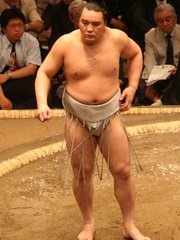
5. Harumafuji Kōhei (b. 1984)
With an HPI of 43.72, Harumafuji Kōhei is the 5th most famous Mongolian Wrestler. His biography has been translated into 14 different languages.
Harumafuji Kōhei (Japanese: 日馬富士 公平; born April 14, 1984 as Davaanyamyn Byambadorj (Mongolian: Даваанямын Бямбадорж)), previously known as Ama Kōhei (安馬 公平), is a Mongolian former professional sumo wrestler. He was the sport's 70th yokozuna from 2012 to 2017, making him the third Mongolian and fifth overall non-Japanese wrestler to attain sumo's highest rank. Harumafuji began his professional career in 2001 and reached the top makuuchi division in 2004. He won ten special prizes for his achievements in tournaments. In November 2008 he became the seventh foreign-born wrestler in sumo history to reach the second-highest rank of ōzeki. In May 2009, he won his first tournament championship. He went on to win a total of nine top division championships, three of them with a perfect record. At 133 kg (293 lb), Harumafuji was the lightest man in the top division as of September 2015. He is noted for his technical skill and his rivalry with fellow Mongolian yokozuna Hakuhō. Harumafuji admitted to assaulting fellow Mongolian wrestler Takanoiwa during a regional sumo tour in late October 2017. He withdrew from the November 2017 honbasho shortly after the allegations surfaced. On November 29, 2017, his stablemaster, Isegahama, submitted Harumafuji's letter of resignation to the Japan Sumo Association.

6. Kakuryū Rikisaburō (b. 1985)
With an HPI of 42.98, Kakuryū Rikisaburō is the 6th most famous Mongolian Wrestler. His biography has been translated into 14 different languages.
Kakuryū Rikisaburō (Japanese: 鶴竜 力三郎; pronounced [kaꜜkɯɾʲɯː ɾiki̥saꜜbɯɾoː], born August 10, 1985 as Mangaljalavyn Anand Mongolian: Мангалжалавын Ананд, Mongolian pronunciation: [ˈmaŋ.ɢəɮ.dʒə.ɮə.w̜iːŋ ˈa.nənt]) is a former professional sumo wrestler from Sükhbaatar Province, Mongolia. He was a member of the top makuuchi division from November 2006 until his retirement in March 2021, and was the 71st yokozuna in history. He reached the third highest sekiwake rank in July 2009, and in March 2012 he secured promotion to the second highest rank of ōzeki after finishing runner-up to yokozuna Hakuhō and accumulating a total of 33 wins in his previous three tournaments. After scoring 14 wins against one loss in both of the first two tournaments of 2014, and claiming the yūshō in the second, he was promoted to yokozuna. He won his second tournament as a yokozuna, a playoff win over Terunofuji in September 2015, but did not win more than 12 bouts in a tournament at yokozuna rank until winning his third tournament in November 2016. Injury problems meant that he was able to complete only one tournament in 2017 but he returned to fitness in 2018 and won his fourth and fifth championships in March and May. He won a sixth championship in July 2019. He has also been a runner-up on eight occasions. In 2020 he obtained Japanese citizenship and changed his name to Mangarajarabu Ananda (マンガラジャラブ・アナンダ). He announced his retirement on March 24, 2021. He is an elder in the Japan Sumo Association under the name of Otowayama (音羽山).

7. Mönkhbatyn Urantsetseg (b. 1990)
With an HPI of 41.77, Mönkhbatyn Urantsetseg is the 7th most famous Mongolian Wrestler. Her biography has been translated into 24 different languages.
Mönkhbatyn Urantsetseg (Mongolian: Мөнхбатын Уранцэцэг, born 14 March 1990) is a Mongolian sambist and retired judoka who competed in the 48 kg category, and World Champion in both sports. In 2021, she won one of the bronze medals in the women's 48 kg event at the 2020 Summer Olympics in Tokyo, Japan. In 2013, she became the first female world champion in judo from Mongolia. At the 2012 Summer Olympics, she was defeated in the quarterfinals. At the 2016 Summer Olympics, she lost to Ami Kondo in the bronze medal match. In 2017, she is gold medalist in the Asian Judo Championship and silver medalist in the World Judo Championship. In 2019, she is bronze medalist in the World Judo Championship in Tokyo. In 2021, she won one of the bronze medals in her event at the 2021 Judo World Masters held in Doha, Qatar and the Summer Olympics held in Tokyo, Japan. She is also two-time World Champion in sambo, in 2010 and 2014.

8. Dorjsürengiin Sumiyaa (b. 1991)
With an HPI of 41.07, Dorjsürengiin Sumiyaa is the 8th most famous Mongolian Wrestler. Her biography has been translated into 24 different languages.
Dorjsürengiin Sumiyaa or Sumiya Dorjsuren (Mongolian: Доржсүрэнгийн Сумъяа, born 11 March 1991) is a Mongolian judoka. Dorjsürengiin competed in the 57 kg event at the 2012 Summer Olympics and lost in the first round. At Astana 2015, she won her first World Championships medal, a bronze. In the 2016 Olympics she won a silver medal in the women's 57 kg event and won gold at the 2017 World Championships in Budapest. In the 2017 World Championships final, Dorjsürengiin defeated Tsukasa Yoshida who had beaten her in the Olympic final. Dorjsürengiin won a bronze medal at the 2018 World Championships, after an unexpected loss in the semi-finals to Nekoda Smythe-Davis. She also competed in the women's 57 kg event at the 2020 Summer Olympics held in Tokyo, Japan. Dorjsürengiin has also won multiple medals at the Asian Games (bronze in 2014 and 2018), Asian Championships (gold in 2016, bronze in 2012 and 2013) and is a four-time national champion. Dorjsürengiin's life was the subject of the 2017 Mongolian film White Blessing.

9. Khashbaataryn Tsagaanbaatar (b. 1984)
With an HPI of 40.18, Khashbaataryn Tsagaanbaatar is the 9th most famous Mongolian Wrestler. His biography has been translated into 19 different languages.
Khashbaataryn Tsagaanbaatar (Mongolian: Хашбаатарын Цагаанбаатар, born 19 March 1984) is the single medal winner from Mongolia at the 2004 Summer Olympics, where he won a bronze medal in judo at the men's –60 kg event. He became the first Mongolian to win a gold medal at the World Judo Championships, doing so in Rotterdam 2009. Khashbaataryn also took gold medal in the 2006 Asian Games. Khashbaataryn also won a gold medal at the 2007 New York Open in the –66 kg weight division. He won with a traditional technique, the kata guruma (shoulder wheel).

10. Tsend-Ochiryn Tsogtbaatar (b. 1996)
With an HPI of 38.22, Tsend-Ochiryn Tsogtbaatar is the 10th most famous Mongolian Wrestler. His biography has been translated into 19 different languages.
Tsend-Ochiryn Tsogtbaatar (Mongolian: Цэнд-Очирын Цогтбаатар; born 16 March 1996) is a Mongolian judoka. He competed at the 2020 Summer Olympics in Tokyo, in the men's 73 kg and won the bronze medal. Prior to the Olympics, he fought the World Junior Championship in 2014 and 2015. He won a bronze medal at the World Cadet Championships in 2013. In 2015, he reached the final of the Abu Dhabi Grand Slam. At the 2021 Judo Grand Slam Abu Dhabi held in Abu Dhabi, United Arab Emirates, he won the gold medal in his event. He won one of the bronze medals in his event at the 2022 Judo Grand Slam Paris held in Paris, France.
People
Pantheon has 16 people classified as Mongolian wrestlers born between 1941 and 1999. Of these 16, 15 (93.75%) of them are still alive today. The most famous living Mongolian wrestlers include Hakuhō Shō, Asashōryū Akinori, and Naidangiin Tüvshinbayar. The most famous deceased Mongolian wrestlers include Jigjidiin Mönkhbat. As of April 2024, 3 new Mongolian wrestlers have been added to Pantheon including Harumafuji Kōhei, Kakuryū Rikisaburō, and Bavuudorjiin Baasankhüü.
Living Mongolian Wrestlers
Go to all RankingsHakuhō Shō
1985 - Present
HPI: 51.76
Asashōryū Akinori
1980 - Present
HPI: 51.27
Naidangiin Tüvshinbayar
1984 - Present
HPI: 45.18
Harumafuji Kōhei
1984 - Present
HPI: 43.72
Kakuryū Rikisaburō
1985 - Present
HPI: 42.98
Mönkhbatyn Urantsetseg
1990 - Present
HPI: 41.77
Dorjsürengiin Sumiyaa
1991 - Present
HPI: 41.07
Khashbaataryn Tsagaanbaatar
1984 - Present
HPI: 40.18
Tsend-Ochiryn Tsogtbaatar
1996 - Present
HPI: 38.22
Bavuudorjiin Baasankhüü
1999 - Present
HPI: 36.54
Dashdavaagiin Amartüvshin
1987 - Present
HPI: 33.98
Lkhagvasürengiin Otgonbaatar
1993 - Present
HPI: 33.84
Deceased Mongolian Wrestlers
Go to all RankingsNewly Added Mongolian Wrestlers (2025)
Go to all RankingsHarumafuji Kōhei
1984 - Present
HPI: 43.72
Kakuryū Rikisaburō
1985 - Present
HPI: 42.98
Bavuudorjiin Baasankhüü
1999 - Present
HPI: 36.54




